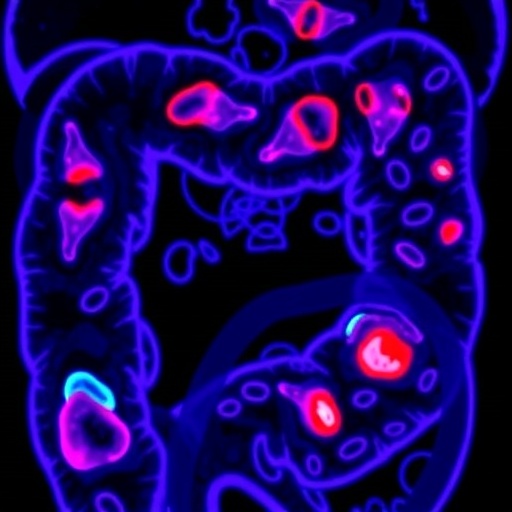A Revolutionary Leap in Understanding Colorectal Cancer Progression: T-Cell Dynamics Illuminate Early Detection Pathways
Colorectal cancer (CRC) remains one of the most formidable challenges in oncology, ranking among the leading causes of cancer-related morbidity and mortality worldwide. At the heart of CRC development lies a complex and dynamic tumor microenvironment, where interplay between emerging neoplastic cells and the immune system dictates disease trajectory. A groundbreaking study from Mass General Brigham researchers now dissects how T-cell populations—critical players in immune surveillance—evolve throughout the colorectal precancer-to-cancer spectrum. This work, published in Cancer Immunology Research, unravels the intricate immunological landscape that defines progression, unveiling promising avenues for earlier detection and therapeutic intervention.
The genesis of colorectal cancer often begins not with overt malignancy but with benign precursor lesions, which may embark on divergent evolutionary paths culminating in invasive cancer. These pathways, typically categorized as conventional adenomatous or serrated, reflect distinct histopathological and molecular hallmarks. Yet, beyond the cellular transformations lies a largely uncharted dimension: the immune microenvironment’s response to these lesions. Prior knowledge highlighted immune involvement in established colorectal tumors, but the nuanced choreography of T lymphocyte distribution and phenotype from normal tissue through precancerous stages to full-blown carcinoma remained elusive—until now.
Leveraging a sophisticated translational approach, the Mass General Brigham team utilized an expansive biobank containing tissue specimens amassed over several decades from three prominent prospective cohort studies. This exhaustive repository permitted an unprecedented longitudinal assessment of 1,825 colorectal samples, spanning normal mucosa, 790 precancerous lesions, and 1,035 colorectal cancers. Employing cutting-edge multiplex fluorescent immunohistochemistry combined with high-throughput imaging platforms augmented by machine learning algorithms, the investigators meticulously characterized T-cell subsets defined by lineage, activation status, and spatial localization within the tissue microarchitecture.
Crucially, the analysis illuminated pronounced heterogeneity in T-cell infiltration patterns as tissue transitioned from healthy states to precancer and malignancy. Variations in CD4+ helper, CD8+ cytotoxic, regulatory T-cell populations, and other subsets emerged, reflecting complex immune remodeling processes aligned with neoplastic progression. The density and distribution of activated T cells appeared predictive not only of lesion presence but also of their malignant potential, suggesting that the immune milieu’s configuration could serve as a biomarker for risk stratification.
Moreover, spatial organization of T cells within the colorectal tissue exhibited strong correlations with immune efficacy. The proximity of effector T cells to neoplastic foci indicated a more vigilant antitumor response, whereas disrupted spatial patterns paralleled immune evasion mechanisms commonly exploited by advanced tumors. These findings underscore how the three-dimensional arrangement of immune components shapes the balance between eradication and tumor escape.
Beyond descriptive insights, this study heralds a paradigm shift toward integrating detailed immunological profiling with conventional histopathology to enhance early detection strategies. Identifying immune signatures characteristic of high-risk precancerous lesions opens avenues for non-invasive diagnostics or targeted surveillance, potentially intercepting CRC at its nascent stages. Furthermore, understanding T-cell dynamics lays the groundwork for immunotherapeutic innovations tailored to modulate the local tumor microenvironment preemptively, thereby improving patient outcomes.
Dr. Shuji Ogino, senior author and a leading figure in molecular pathological epidemiology, emphasizes the transformative potential of this research. He notes, “By delineating the evolving immune landscapes and T-cell infiltration nuances throughout colorectal tumorigenesis, our work reveals critical windows of opportunity for earlier intervention and precision immunomodulation.” His team’s approach exemplifies a novel prospective cohort incident-tumor biobank method (PCIBM), uniquely combining long-term epidemiological data with sophisticated tumor immune profiling—an endeavor unprecedented in human cancer research.
Such comprehensive longitudinal data not only facilitate mechanistic understanding but also empower predictive modeling of colorectal carcinogenesis. Integrating immune parameters with molecular and clinical variables can refine risk algorithms and personalize screening protocols. This fusion of immunology and pathology paves the way for a new generation of biomarkers and therapeutic targets confined not to late-stage cancer but encompassing its earliest immunologically active precursors.
The study’s methodological rigor and interdisciplinary scope stand out. Employing machine learning-enabled image analysis allowed quantification of T-cell features with unparalleled resolution and throughput, overcoming limitations inherent in manual pathological assessment. This convergence of technology and biology exemplifies the future of oncological research, wherein data-intensive, systems-level insights catalyze translational breakthroughs.
Notably, institutional support from prominent funders such as the U.S. National Institutes of Health, Cancer Research UK Grand Challenge Award, Prevent Cancer Foundation, and the American Institute for Cancer Research helped realize this ambitious investigation. The collaborative roster features experts spanning pathology, immunology, epidemiology, and oncology, including prominent investigators like Yasutoshi Takashima, Andressa Dias Costa, and numerous others. Their collective expertise underscores the complex multidisciplinary nature of contemporary cancer research.
While the implications for clinical practice emerge as profound, the study’s authors acknowledge the necessity for further validation and exploration of mechanistic underpinnings. Future endeavors will aim to refine immune-based biomarkers, evaluate their predictive accuracy prospectively, and test immunomodulatory strategies in early neoplastic contexts. The goal is to translate these immunological insights into actionable diagnostic and therapeutic frameworks that significantly reduce CRC incidence and mortality worldwide.
In summary, this landmark study revises traditional views of colorectal cancer progression by placing T-cell immunity at the epicenter of neoplastic transformation. The nuanced spatiotemporal portrait of T-cell subset evolution challenges prevailing paradigms and invites a new era focused on the immune microenvironment as both a sentinel and an interventional target. As the global burden of colorectal cancer continues to escalate, innovations stemming from this research promise to revolutionize early detection, risk prediction, and personalized immunotherapy, heralding measurable advances in patient care and survival.
Subject of Research: Human tissue samples
Article Title: T-cell Subset Features and Distributions Evolve Across the Colorectal Precancer–Cancer Spectrum
News Publication Date: 12-Nov-2025
Web References: https://doi.org/10.1158/2326-6066.CIR-25-0481
Keywords: Colorectal cancer, Tumor microenvironments




